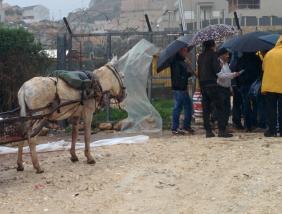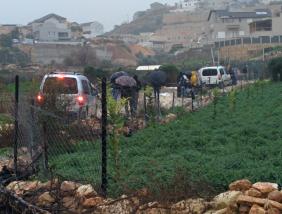'Azzun, 'Azzun 'Atma, Beit Amin, Jalud
C Zone. The agricultural CP named Beit Amin – Gate 1447
Most agricultural areas are situated in the seam zone near the Oranit gate. The Beit Amin gate is distanced about one kilometer from the Oranit gate, and the Palestinians, some of which arrive from Azzun and Azun Atma, are obliged to get to gate 1447 and to walk from there to the region of the Oranit gate. Complaints are voiced about the difficulty in walking along the fence to the place of their work, as they are forbidden to go there with cars. They also complain that there is no shed to protect them from the weather hazards.
This is the only gate in the region, after the Oranit Gate has been closed down. Only land owners who live east of the separation fence, and the fence separates between them and their lands and this place of work, are allowed to pass by this gate.

From the road to the gate leads a dirt track transversed by Wadi Qana. During the last months in this Wadi flows sewage which overflowed from the sewage installation of Sha'arey Tiqva. In the wadi there is also a concentration of rain water, and today the flow is extremely strong.

7:30 – During the last half hour there is a strong rain. In the nearby greenhouse the farmers wait for the soldiers to come and open the gate. We joined the waiting. In the meantime they tell us in fluent Hebrew about the daily hardship of getting to their lands from their dwelling places in the villages of the region including Azzun and Azzun Atma, and the passage to the zaatar plots, which consists for some their only source of income, in order to cultivate the plots and make a living. About twenty people are here today, on this rainy day. According to them usually about 100 people wait for the opening of the barrier in order to go and process their plots. In the quarter of an hour until the opening of the CP about 20 more people arrive.
Our interlocutors make a comparison: From a situation of a 5 minutes' drive in a vehicle, or a 20 minutes' walk from their home to their field, they are obliged to set out much earlier in order to be sure that they won't miss the time lapse during which the CP is open, even when the time doesn't suit the kind of work they are interested to perform. And they must be sure not to forget anything at home… and if there is an emergency call from home one must wait until the forthcoming opening period of the CP. For these people sudden changes in their plans are absolutely impossible…
Another, remoter CP, near Jalud, number is 1419, named the Abu Salaman CP, was opened at 5:30 in the morning for 20 minutes. This CP is almost not in use. A few people, 2-3, pass there in the morning we are told. It is also opened at 15:30 pm according a DCO document.
The CP was opened at 07:45, on time. Everybody is under a pouring rain.
After passing through the CP, on the way to their plots, there is no possibility of driving. The road is intended for military vehicles only. A donkey with a cart was allowed to pass. The workers are forced to walk another twenty minutes, each to his plot, after the waiting and the passage through the CP, in rain or in sunshine, in cold or in heat.
After we watched the passage of the farmers we drove about 40 minutes to reach the proximity of the same region on the Israeli side. We met some of the same people we talked to before they passed through the CP. They were now loading agricultural produce… Greeting and surprise that we arrived again to see them at their work – but on the Israeli side.
